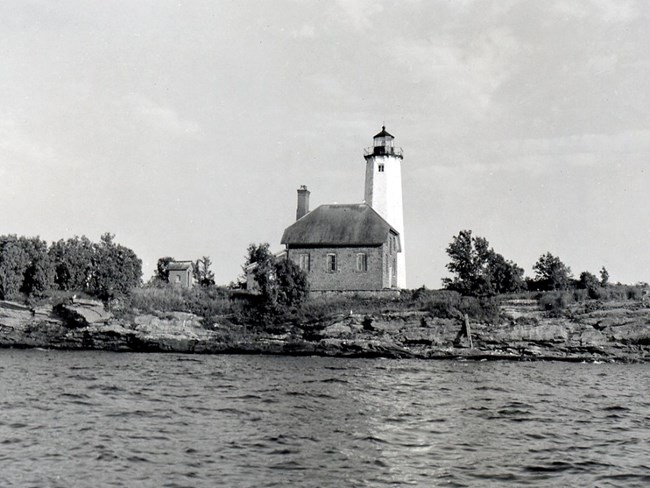Last updated: February 17, 2021
Article
Isle Royale Lighthouse

National Visual Inventory Cards 60-196 / S. Viers
Summary
The Isle Royale Light stands on long, rocky Menagerie Island via Isle Royale's south shore at the entry to Siskiwit Bay. Reachable only by private boat, it features a 61-foot double-walled octagonal sandstone tower, with a black lantern and gallery. It was completed and operative in 1875, and automated in 1913. The original Fourth Order Fresnel lens and subsequent light systems have been replaced with a 12-volt solar power 300 mm Tidelands Signal Acrylic Optic, which sends its beam out 10 miles.
History
The second copper mining boom on Isle Royale began in 1873, once again bringing ships into Isle Royale's rocky harbors. This wave of mining ventures incited the creation of the island's second lighthouse, the Isle Royale Lighthouse. The Isle Royale Lighthouse was sited on Menagerie Island at the entrance to Siskiwit Bay, where the profitable Island Mine Company was located. Authorization was given for the new lighthouse in order to light the passage into the bay, which had a dangerous access. It was completed by 1875. In addition to guiding ships into the harbor, the Isle Royale Lighthouse also warned Lake Superior traffic of the existence of the island's south shore.
The structure consists of a hip-roofed lightkeeper's house attached to a 61-ft octagonal tower by covered walkway. All of sandstone possibly quarried near Jacobsville on the Keweenaw Peninsula. Light automated in 1939.
The light tower is an octagonal red sandstone structure that is sixteen feet in diameter at the base and ten feet nine inches in diameter at the parapet. It is surmounted by a cast iron lantern of ten sides, with an inscribed diameter of seven feet. The tower is constructed using a cavity wall system which allows for thorough ventilation of the tower wall cavity. It ties in with the lantern ventilation system in the lantern parapet walls. The inner wall is constructed of brick with an interior layer of plaster while the outer is of stone that has been whitewashed. The outer wall of the tower, bearing the load of the watch tower and lantern, is forty inches thick at the base and ten inches thick at the parapet, separated by a two inch air space from the inner wall, which supports the stairs and is eight inches thick at the base and two inches thick at the parapet. Overall, the light tower is sixty-one feet high and produces a focal plane seventyfive feet above the mean low water level of Lake Superior.
The top of the tower is reached by a segmental cast iron and steel spiral staircase. Three wood frame windows that are deeply recessed in the tower provide natural day lighting to the stair. The lowest window has a cast iron and steel storm shutter to provide protection from exterior elements. At the top of the landing is a cupboard used to store cleaning rags and other necessaries. The lantern is constructed of cast iron. The interior of the lower part is lined with vertical wood strips. The cast iron, pyramidal dome is lined on the interior with sheet zinc. A small tin cone lens protector is attached to the roof. The lantern is of the fourth order. The exterior balustrade is constructed of two rails and vertical stanchions with ball tops.
The Keeper's Dwelling is rectangular, twenty-eight feet by forty-five feet, with a hipped gable or jerkinhead gable roof sheathed in wooden shingles, and is constructed of rough coursed red sandstone. The National Park Service installed a new roof on the dwelling in 1986. A brick chimney with a decorative cast iron chimney cap punctuates the roof which has galvanized metal coping on the hips and ridge. The dwelling has eight rooms. In addition, there are four closets on the first floor and one closet on the second. Windows include six-over-six and three-over-six double hung. Foundation windows are three light wood frame in a top hinged hopper sash. Iron shutters were installed to protect window areas from crashing waves in severe storms. The basement was used as a store room. A one story shed roofed kitchen wing exists on the northeast end of the dwelling. The kitchen floor has collapsed, but the integrity of other interior finishes is very high. The dwelling is connected to the light tower by a covered passageway eight feet long.
Quick Facts
| Attribute | Data |
|---|
